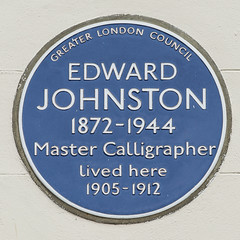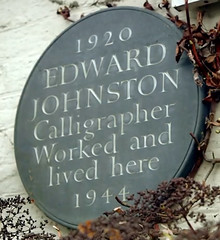

Edward Johnston
(1872-1944)
Died aged c. 72
Wikidata WikipediaEdward Johnston, CBE (11 February 1872 – 26 November 1944) was a British craftsman who is regarded, with Rudolf Koch, as the father of modern calligraphy, in the particular form of the broad-edged pen as a writing tool. He is most famous for designing the sans-serif Johnston typeface that was used throughout the London Underground system until it was redesigned in the 1980s. He also redesigned the famous roundel symbol used throughout the system.
DbPedia
Commemorated on 4 plaques
Edward Johnston 1872-1944 master calligrapher lived here 1905-1912
3 Hammersmith Terrace, Hammersmith, London, United Kingdom where they lived (1905-1912)
Edward Johnston Calligrapher Worked and lived here 1920 1944
'Cleves', 40 Lewes Road, Ditchling, United Kingdom where they was
Railway Heritage Feature Directional sign from Blackfriars tube station, (c1930) This vitreous enamel sign was situated inside the entrance to the original Blackfriars station and was salvaged during the building work in c1975. The station was heavily redeveloped during that period, resulting in the demolition of the original c1870 highly ornate facade. The sign is typical of those designed for use on the Underground during the late 1920s and early 1930s when much thought was given to the standardisation of sign design and typefaces used. The sign displays the ones heavy timber frames used – In the early 1930s Charles Holden developed a slimmer bronze frame for signs used on new and reconstructed stations. It appears that many older stations that received new signs at this time continued to have the timber framed versions. The pale yellow background was also commonly used – along with the use of the purposely designed Johnston black lettering that works so well in this situation being both legible and authoritative. The style of the arrow, the flight of which appears to pierce the ring of the roundel, is also indicative of the sign’s age. This device, commonly known as ‘Mexican arrow’, was used on signs from the mid-1920s until the 1960s as a unique graphic tool and also added familiarity to the brand London Transport. The use of four flights to the arrow dates it to the years either side of 1930. By c1932 it was used with three flights and later decades saw the number gradually drop to two, then one and finally none. The site was donated by Mr. A H Rolph
55 Broadway, London, United Kingdom where they was
Railway Heritage Feature Richmond Station sign (c1935-38) This vitreous enamel sign stood, for many years, outside Richmond Richmond mainline station. Photographic evidence shows it in place by the late 1930s and it appears to have been removed during the 1970s. The date of manufacture can certainly be better understood given the overall design and various styles of lettering and logos it shows. During the 1930s, when the new London Transport (formed in 1933) experimented with various designs of signs, most used his pale yellow background with the maroon border. The arrow at the base of the sign was known as a ‘Mexican arrow’ and this example, with three flights on the arrow, dates it to post 1933, as prior to that date it would have had four flights. The sign also uses colour blocks as background to the text and this was increasingly used as a device by the Underground during this period. The design of some signs was further standardised when, in 1938, LT issued the first ‘Standard Signs Manual’. Richmond was owned and primarily served by the Southern Railway who, during this period developed their own ‘house style’ that included this “sunshine” style of lined out lettering. The underground logo, using the company’s Johnston typeface, has the distinctive white bands (or “ribbons”) above and below the letters. Then, as now, Richmond was served by the district line. The “LMS” lettering refers to the London Midland & Scottish Railway, another of the ‘big four’ railway companies that had been formed in 1923, and ran the North London Railway services between Richmond and Broad Street. This service is now provided by London Overground The sign is a fascinating reminder of an earlier period of ‘co-ordination’ of elements of London's transport service that finally came to fruition with the formation of TfL. LU acquired the sign in 2008 from a private collector, who had salvaged the sign when it was removed, and is displayed here as part of LU’s heritage.
55 Broadway, London, United Kingdom where they was



